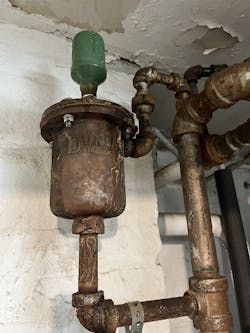Latest from Hydronics
Sponsored
Whether you have a hot water system or a steam system, you want to get rid of the air. In a hot water system, if enough air accumulates in one place in the system, it can stop water circulation. It could be the piping, radiation, pump, etc. It is an annoying problem when it happens, so the modern way to control it is with an in-line air eliminator on the supply pipe leaving the boiler, with the expansion tank connected to the bottom, and the circulator(s) “pumping away” from the expansion tank connection.
If you have any questions on that, my column, "Location, Location, Location," for the April 2020 issue explains the importance of the pump to expansion tank location in further detail. You don’t have to retrofit every job, but you want to “pump away” whenever you do a replacement. It keeps you out of trouble and the customer has a nice quiet and comfortable home.
Not a Bucket Trap
Air is also a problem in steam systems. Air and steam are both gases, but they don’t mix. Where one is, the other can’t be. With that in mind, Dunham came up with a way to get rid of the air in a two pipe steam system. This was in the days of the hand-fired coal systems. As the steam started to circulate into the piping, it pushed the air out of the way, further down the pipe.
The Dunham Air Eliminator was located in the boiler room, at the end of the piping. It had a great big hole for the air to be pushed out of. They knew that the quicker you get the air out of the system, the quicker and more evenly the steam moved through the system. That big hole, on this example, is where somebody screwed on a Hoffman #75 main air vent, which has a tiny hole for the air to be pushed out.
Don't Block the Air Vent
When he first texted the photo, I immediately recognized it because I see this all the time. Whether it is a Dunham or a Trane or a Wester or a Hoffman, somebody puts that main air vent on the big hole. They all have it, and it is not supposed to be blocked by the addition of a main air vent, because it is already the main air vent.
To give you an idea of how small the hole in the #75 main vent is, I had someone smarter than me calculate the difference. According to his calculations, using the actual size provided by Hoffman, it would take 64 of the #75 main vents to equal that ¾” hole in the Dunham vent. That is a huge difference and not much of a “main” vent.
For the system shown in the photo, all of the air has to pass through the tiny hole in the #75 main vent. There is a lot of air in the piping and radiation of a two pipe steam system. Typically, all the air in the steam mains pass through a radiator style steam trap, like a #17C, to the dry return, the portion of the return piping that is above the waterline. The hole in the #17C, or other brand radiator trap, is plenty big enough.
Once in the dry return, the air moves to the generously sized open air vent on the Air Eliminator, or in this case to the tiny hole in the single #75 main air vent. This is also the hole that all the air in the radiators has to pass through. This air is also using the dry return to find its way out of the system, so the steam can take its place and heat the building.
Suffering in Silence
The reason that someone installs the vent on top of the vent is usually the same. The radiator traps on a few radiators start failing to close off at the presence of steam. This allows the steam to enter the dry return, go through the giant hole in the Air Eliminator, and show up in the ceiling of the boiler room. The Air Eliminator does not have a thermostatic element inside to shut off to the presence of steam.
The #75 main air vent does have a thermostatic element. When installed on the Air Eliminator, it keeps the steam from escaping, but vents very little air. Not to mention the fact that the traps need to be repaired or replaced. The whole system is suffering in silence—but there isn’t any steam coming out, so that someone packs up his tools and goes to the next job.
My response to the text was a shortened version of this column. First I told him that it wasn’t a trap and then I told him to take off the #75 and fix the traps. With all the traps working to keep the steam out of the dry return, the air passes freely out of the system to allow the steam to follow quickly to provide even heat.
The Air Eliminator does have a float inside to prevent the water from the system to push out if the steam pressure gets too high. I will discuss that issue in an upcoming column about the ever changing water level in the return piping of a steam system.
In the United Kingdom they celebrate a holiday that we could copy. It is “Boiler Switch on Awareness Day,” the Monday of 3rd full week of October. This year it is October 17th. If you have a newsletter or customer contact email list, urge your customers to prepare for the upcoming heating season like our British friends. God save the King!
Patrick Linhardt is a thirty-seven-year veteran of the wholesale side of the hydronic industry who has been designing and troubleshooting steam and hot water heating systems, pumps and controls on an almost daily basis. An educator and author, he is currently Hydronic Manager at the Corken Steel Products Co.
Patrick Linhardt
Patrick Linhardt is a forty-one-year veteran of the wholesale side of the hydronic industry who has been designing and troubleshooting steam and hot water heating systems, pumps and controls on an almost daily basis. An educator and author, he is currently Hydronic Manager at the Corken Steel Products Co.



